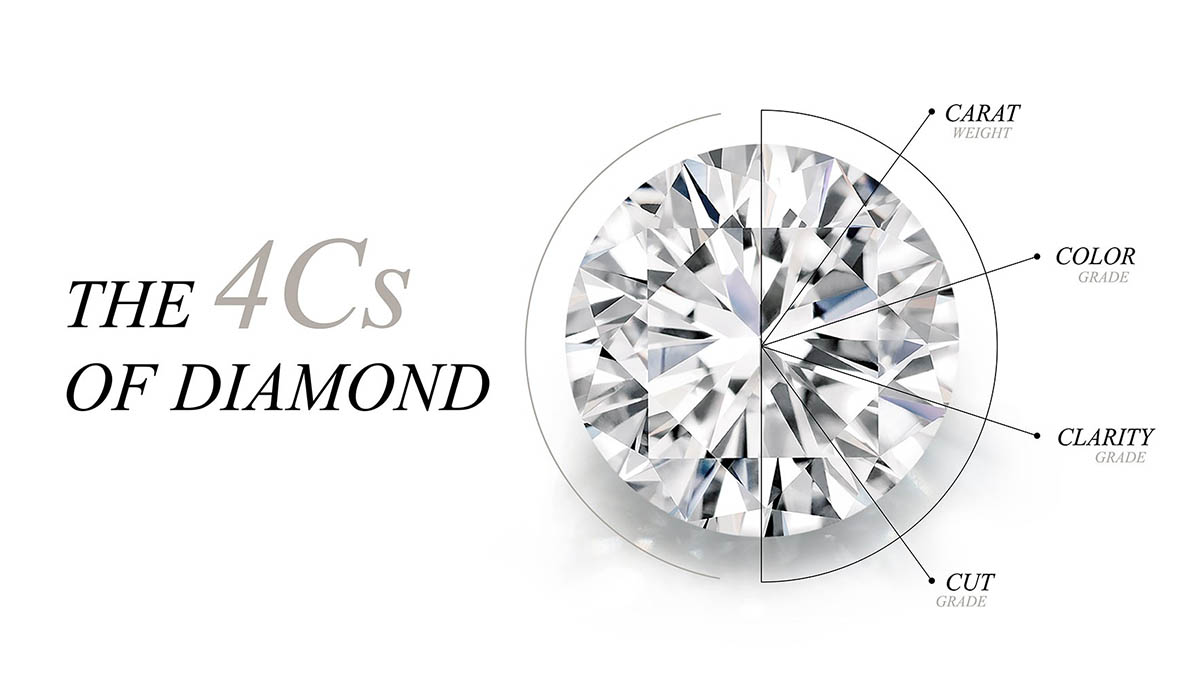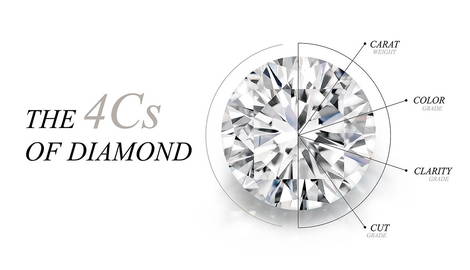
Picking a beautiful diamond is more than meets the eye (literally). Besides looking for unique styles of jewelry, the rarity of a diamond is best understood through its science. Below, we explain the 4Cs – cut, colour, clarity, and carat weight – the most important characteristics to understand when making a diamond purchase whether for an engagement ring or just because.
C For Cut

A diamond’s cut is the most important of the 4 Cs because it determines how dazzling it will be to your naked eye. But cut is different from shape (such as round or heart). The shape is made up of its cuts, meaning the individual geometric parts of it. Cuts affect each part of a diamond, and have to be perfectly symmetrical to for a polished appearance.
According to Lumera, 75% of diamond jewelry sold is fashioned to be round. Circular diamonds are known to dazzle the brightest, but there are other popular shapes available. The princess is a popular choice for engagement rings. Others opt for the oval shape because its elongated appearance gives the illusion of a bigger stone. But the cut should be done well. Even if a diamond is perfectly clear, a bad cut can turn it into a bad diamond.

You might be wondering why someone would cut a diamond poorly. The answer lies in the carats, or weight of the stone. Sometimes a diamond will only become perfectly clear if its cut to a very small, concentrated part of its original chunk. However, jewelers may want to keep it above 1 or 2 carats so they can market it for a higher price. Thus, the diamond cutter may reject fine-tuning it in favor of preserving its weight.
C For Color

Another crucial party of the 4 Cs is color. Colorless diamonds are marketed the most because a clear composition indicates that the stone is chemically pure. Many diamonds come with a yellow or light brown tint. While these colors can be beautified into honey or earth-themed jewelry, it’s the blue, pink, and red-colored diamonds that are more desired. These are called fancy diamonds, and the best ones are labeled as vivid (meaning they have more than a tint).
However, fancy diamonds are extremely rare, making up less than 0.1% of those mined worldwide. Even the most expensive diamond ever sold was actually pink instead of colorless. The Pink Star is a large, vivid, rosy oval-shaped stone that sold for $71 million in 2017. Thankfully, you don’t need to spend that much to take a fancy diamond home.

Some sites sell pink diamond rings for about $3 K. Zales offers a variety of yellow rings and earrings that go from about $5 K to $15 K. Blue diamonds are rarer, so most of your options would be enhanced. Enhanced diamonds are those that have been treated to improve their clarity, or deepen their color. While this can make unique designs more affordable, you should know that treated diamonds are harder to resell later because they become less durable.
C For Clarity

The next C is clarity. A diamond’s clarity is determined by its inclusions and blemishes. Inclusions are marks inside it, and blemishes are external. Diamonds with no inclusions are incredibly rare, making them more expensive. These marks can take on a variety of characters, including graining, nicks, dark spots, feathers, clouds, and scratches.
Many people buy gems with inclusions, though, because they’re usually only noticeable under a magnifying glass. Like the first two C’s, there’s also a scale for this. It goes from the most flawed (labelled as I1-I3 for Imperfect) to the least (FL-IL for Flawless / Internally Flawless ). Less than 1% of diamonds are ranked as Flawless (FL), but that doesn’t mean that anything less than that isn’t worth it.
Since flawless diamonds can be wildly more expensive, it’s recommended to buy an imperfect one anyway if the price is right. Opt for a VS1 (Very Slight Inclusions) or better rating for a diamond with marks that are barely noticeable.
C For Carat Weight

Carats might be the most well-known of the 4 Cs. They’re determined by a diamond’s physical weight measured by metric carat (worth 200 milligrams). Many jewelers will price their stones per this standard.
Even if a diamond appears larger to your eye, you should weigh it to ensure that its shape isn’t fooling you As mentioned earlier, oval is one of the shapes that looks larger than it is. The marquise and emerald styles have the same effect. Essentially, it’s stone’s table cut that can change our perception of its carats.
The 1-carat diamond is a popular standard that many companies try to reach because they can sell it for a higher price. Some companies will sell a 0.9-carat stone for a few thousand dollars less just because it doesn’t hit that mark! The difference is usually unnoticeable. A popular rule of thumb is that adjusting by 0.2 carats is required to make a real difference.
Yet, it’s important to note that you shouldn’t take what your jeweler says at face-value. Look into getting a diamond evaluation report from a 3rd party to determine if your prospective new ring or watch is as perfect as they say. There are major institutions across continents to grade your diamonds, such as the Diamond High Council (HRD), and the International Gemological Institute (IGI).
Once you’ve determined the worth of the individual stone, you can turn an eye to its design.
Long-gone, unique designs

If you’re shopping for jewels from Sotheby’s or Christie’s, look for historical styles that aren’t as common anymore.
One example is Georgian jewelry, which is very rare. Jewelry from this era, which lasted from 1714-1830s, were tailored to the gem’s shape instead of vice versa. This was because they didn’t have the technology to cut the stones as precisely as we do today. Themes in their designs also often featured flowers, bows, and lace.
Another more recent goldmine for jewels comes from the Art Deco period in the early 1900s. Auction House Christie’s has noted that original art deco earrings are hard to find. Keep an eye out for lavish, creative designs made for Hollywood stars in the 30s if you believe more is more.
Some of the most valuable gems are those attached to a story. The Hope Diamond is one of the most valuable examples in existence. It carries a 45.52-carat blue diamond at the center and is worth about $350 million. However, it’s rumored to be cursed due to the belief that the French merchant, Jean-Baptise Tavernier, stole it from a Hindu statue. Since then, the untimely deaths of many of those who had the gem went down to earn it an ominous reputation.

Signature designs by major brands can also be very valuable. Take Wallis Simpson’s Cartier panther bracelet, for example. Wallis Simpson is famous for having an affair with England’s King Edward VIII. When the royal family didn’t allow him to marry her, he chose to abdicate from the throne in 1936. Her bracelet’s beauty matched the grandeur of this scandal; it was a panther encrusted entirely in diamonds and onyx. About 7 decades later, it was sold for about $7 million at auction.
However, you don’t have to sweat the style as much as the stones that make it up. Jewelry is more than the sum of its parts, but its parts can make or break overall durability and dazzle. Still, the next time you find a beautiful gem, you may want to ask your jeweler where it falls on the 4 Cs scale, and if it has a story too.







